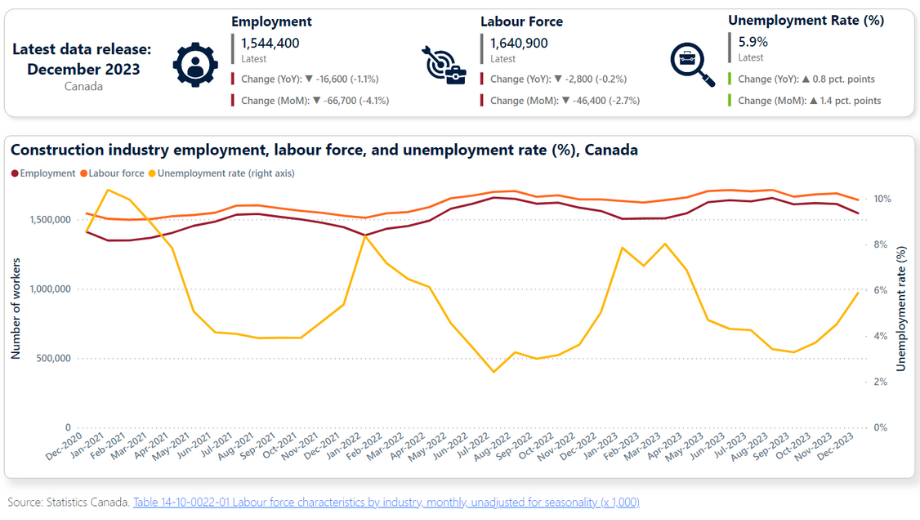Although national, all-industry labour market indicators ended 2023 on a relatively quiet note, data from Statistics Canada’s December 2023 Labour Force Survey shows labour conditions may be easing across the construction sector.
National, all-industry data for the month finds employment holding steady at 20,313,000 in December. That figure was unchanged from November. Statistics Canada reports that employment growth slowed in the second half of 2023, averaging 23,000 per month. It averaged more than double that figure at 48,000 per month during the first six months of the year.
Canada’s unemployment rate also held steady – at 5.8% – in December. This followed increases in five of the previous seven months; from April to November, the rate rose by 0.8 percentage points. In December, there were 1.2 million unemployed people, an increase of 202,000 (+19.3%) compared with 12 months earlier.
Construction sees employment trends ease as December’s unemployment rate approaches historical averages
Construction employment in Canada experienced a marginal decline in December, decreasing by 4.1% from November, equating to a loss of 66,700 jobs. When compared year-over-year, employment in December 2023 was down just 1.1% from December 2022. The labour force witnessed a lesser decline of 2.7% from November and a marginal 0.2% decrease on a year-over-year basis. The overall unemployment rate in the industry rose to 5.9% in December, marking a month-over-month increase of 1.4 percentage points; the year-over-year increase was less significant at 0.8 percentage points.

The total industry employment in December stood at 1.54 million, with a labour force of 1.64 million. The alignment of labour force growth with employment partly explains the increase in the industry’s national construction unemployment rate.
A notable trend throughout 2023 was the increasing employment of women in the construction sector. For women aged 15 years and over, employment rose by 7.8% for the year. Notably, the employment of women 15 to 24 years of age surged by 60% year-over-year, increasing from 10,500 in 2022 to 16,800 in 2023. This rise aligns with the significant federal support for apprenticeship development and the industry’s ongoing labour force challenges. The marked increase in the youngest female age group may be indicative of an outdated perception about young women’s lack of interest in construction careers.
Provincially, the year-over-year employment situation in December was mixed. British Columbia, Ontario, and Nova Scotia were the only provinces that did not record employment gains in December. British Columbia saw an 8.9% decrease, largely due to the completion of several major projects; Ontario experienced a 4% decline, mainly due to reduced residential construction activity caused by higher interest rates; and Nova Scotia witnessed a 6.5% decrease, primarily due to a slowdown in healthcare-related construction and lower demand for new housing.
The largest employment gains were in Prince Edward Island and New Brunswick, with year-over-year increases of 14.7% and 11.3%, respectively. Other provinces saw gains between 4% and 5%, except Saskatchewan, which had a modest 2.2% increase.
Manitoba and British Columbia reported the lowest unemployment rates at 4.4% and 4.5%, respectively. Manitoba’s rate decreased from 4.8% in 2022, while British Columbia saw a slight increase from 4.3%. The most significant year-over-year unemployment increases were in Newfoundland and Labrador, rising to 21.5% from 15.3%, and Saskatchewan, increasing from 5.7% to 9.9%. Alberta’s unemployment rate decreased from 7.7% in 2022 to 5.8% in 2023, while Ontario saw a rise from 3.1% to 5.8%.
Overall, despite slight increases in the industry unemployment rate in December 2023, the rate of 5.9% aligns more closely with historical averages for this time of year.
For the year, the construction sector’s labour force was estimated to have averaged 1.67 million, an increase from 1.63 million in 2022. This represents the third consecutive year of growth in the construction labour force. Employment has followed a similar trajectory, reaching an average of 1.6 million in 2023, marking the first time it has hit this level. Despite these increases, the average unemployment rate in the sector did rise, although marginally, from 4.7% in 2022 to 5.3% in 2023.

Construction Key Indicators
